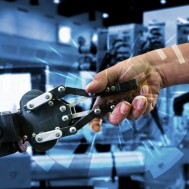As many have predicted, automation has begun to displace humans in the workforce. In the next 15 years, 38 percent of jobs in the U.S. are at high risk of being replaced by robots and artificial intelligence. The effect, however, isn’t just replacing people – it’s adding advancements that will enable us to work in new, innovative ways.
JiLL, for example, is a robot that can greet and support staff, visitors and couriers with a range of front of house tasks. This can include check-in for meetings, providing directions, contacting hosts and recording and reporting technology or building maintenance issues.
As these changes continue to occur, industry leaders are challenged to prepare for the future. Here’s how manufacturers are planning to save jobs in the robot age.
New manufacturing jobs are infiltrating the industry.
With 260,000 robots currently employed in North American factories, there’s reduced demand for low-skilled labour. Cognitive computing assistants, for example, can be configured to complete repetitive, time-consuming work such as client profile updates, credit card applications or registrations. Software robots, on the other hand, can assume other human-like duties such as appointment scheduling, auto-correspondence or other office functions.
“Contrary to fearsome scenarios about robots replacing humans,” explains Peter Miscovich, managing director of JLL, “cognitive computing, robotics and workforce automation feature prominently in most projections of the future workplace.”
Instead of simply replacing jobs, this emerging trend of human-to-machine collaboration will create new careers — increasing the need for high-skilled workers to program, install, run and maintain robots. This concept is not new, of course. Workforce tasks have been automated as early as the Industrial Revolution. Agriculture, for one, used to account for 41 percent of U.S. jobs. Now, that number is under 2 percent. This change didn’t lead to mass employment, but instead transformed the type jobs.
Manufacturers are training employees for the future.
Seventy percent of executives report that their current workers do not have adequate technology and computer skills; over two-thirds indicate that they lack adequate problem solving skills; and 60 percent indicate that they lack sufficient math skills. That’s an issue if manufacturers are looking to fill high-skilled manufacturing positions.
“The only way to fight [job losses],” explains Colin Parris, the vice president of Software Research at GE “is to train the talent that we have. Because in the future, we have to embrace robotics. It allows us to reduce cost. If I reduce cost, I have more money that I can use for innovation. The more money I have, the more new products I can create. The more products I create, the more workforce I can hire.“
Organizations are starting to catch on – manufacturers report on average spending $535 and providing 27 hours of training per employee.
Industry leaders are changing manufacturing perceptions.
There’s a clear issue with the public’s perception of manufacturing jobs. In a poll conducted by the Foundation of Fabricators & Manufacturers Association, 52 percent of all teenagers said they have no interest in a manufacturing career. Two-thirds of these teenagers perceived a manufacturing career entailed a “dirty, dangerous place that requires little thinking or skill from its workers and offers minimal opportunity for personal growth or career advancement.”
Modern manufacturing facilities, however, consist of robots and computerized machinery run by human operators who manage hardware, software and tooling to work per specifications with materials. The challenge leaders are left with is changing the misperceptions about manufacturing and raising awareness of a financially attractive and stable career. A big part of this is rethinking recruitment strategies, such as:
- Utilizing social media. Millennials and generations following are looking to work for a collaborate, flexible business – and manufacturing doesn’t usually fit that mold. By using social media to show a ray of information, applicants can learn about an employer and its culture.
- Reaching women. Women make up about 47 percent of the labor force, but only 27 percent of the manufacturing workforce – showing a large source of untapped talent. The Manufacturing Institute’s STEP Ahead initiative, for one, promotes the role of women in manufacturing through the STEP (Science, Technology, Engineering, and Production).
- Engaging with students. Manufacturing leaders are realizing they have to attract future employees at a young age. The Manufacturing Institute, for example, launched the Dream It. Do It. in order to change the perception of the industry and inspire next-generation workers to pursue manufacturing careers.
The future of manufacturing jobs: What’s next?
Here at Apple Rubber, we use robots to help prevent repetitive motion injuries and create a safer work environment. What is your manufacturing organization doing to save jobs in the age of robots? We’d like to hear from you. Let us know by tweeting us at @AppleRubber.
